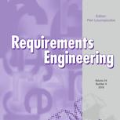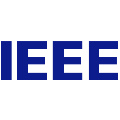Requirements Engineering (RE) is a critical phase in software development including the elicitation, analysis, specification, and validation of software requirements. Despite the importance of RE, it remains a challenging process due to the complexities of communication, uncertainty in the early stages and inadequate automation support. In recent years, large-language models (LLMs) have shown significant promise in diverse domains, including natural language processing, code generation, and program understanding. This chapter explores the potential of LLMs in driving RE processes, aiming to improve the efficiency and accuracy of requirements-related tasks. We propose key directions and SWOT analysis for research and development in using LLMs for RE, focusing on the potential for requirements elicitation, analysis, specification, and validation. We further present the results from a preliminary evaluation, in this context.
相關內容
Modeling structure and behavior of software systems plays a crucial role, in various areas of software engineering. As with other software engineering artifacts, software models are subject to evolution. Supporting modelers in evolving models by model completion facilities and providing high-level edit operations such as frequently occurring editing patterns is still an open problem. Recently, large language models (i.e., generative neural networks) have garnered significant attention in various research areas, including software engineering. In this paper, we explore the potential of large language models in supporting the evolution of software models in software engineering. We propose an approach that utilizes large language models for model completion and discovering editing patterns in model histories of software systems. Through controlled experiments using simulated model repositories, we conduct an evaluation of the potential of large language models for these two tasks. We have found that large language models are indeed a promising technology for supporting software model evolution, and that it is worth investigating further in the area of software model evolution.
The robot development process is divided into several stages, which create barriers to the exchange of information between these different stages. We advocate for an interactive lifecycle representation, extending from robot morphology design to learning, and introduce the role of robot description formats in facilitating information transfer throughout this pipeline. We analyzed the relationship between design and simulation, enabling us to employ robot process automation methods for transferring information from the design phase to the learning phase in simulation. As part of this effort, we have developed an open-source plugin called ACDC4Robot for Fusion 360, which automates this process and transforms Fusion 360 into a user-friendly graphical interface for creating and editing robot description formats. Additionally, we offer an out-of-the-box robot model library to streamline and reduce repetitive tasks. All codes are hosted open-source. (\url{//github.com/bionicdl-sustech/ACDC4Robot})
While semi-supervised learning (SSL) has yielded promising results, the more realistic SSL scenario remains to be explored, in which the unlabeled data exhibits extremely high recognition difficulty, e.g., fine-grained visual classification in the context of SSL (SS-FGVC). The increased recognition difficulty on fine-grained unlabeled data spells disaster for pseudo-labeling accuracy, resulting in poor performance of the SSL model. To tackle this challenge, we propose Soft Label Selection with Confidence-Aware Clustering based on Class Transition Tracking (SoC) by reconstructing the pseudo-label selection process by jointly optimizing Expansion Objective and Shrinkage Objective, which is based on a soft label manner. Respectively, the former objective encourages soft labels to absorb more candidate classes to ensure the attendance of ground-truth class, while the latter encourages soft labels to reject more noisy classes, which is theoretically proved to be equivalent to entropy minimization. In comparisons with various state-of-the-art methods, our approach demonstrates its superior performance in SS-FGVC. Checkpoints and source code are available at //github.com/NJUyued/SoC4SS-FGVC.
Effectively explaining decisions of black-box machine learning models is critical to responsible deployment of AI systems that rely on them. Recognizing their importance, the field of explainable AI (XAI) provides several techniques to generate these explanations. Yet, there is relatively little emphasis on the user (the explainee) in this growing body of work and most XAI techniques generate "one-size-fits-all" explanations. To bridge this gap and achieve a step closer towards human-centered XAI, we present I-CEE, a framework that provides Image Classification Explanations tailored to User Expertise. Informed by existing work, I-CEE explains the decisions of image classification models by providing the user with an informative subset of training data (i.e., example images), corresponding local explanations, and model decisions. However, unlike prior work, I-CEE models the informativeness of the example images to depend on user expertise, resulting in different examples for different users. We posit that by tailoring the example set to user expertise, I-CEE can better facilitate users' understanding and simulatability of the model. To evaluate our approach, we conduct detailed experiments in both simulation and with human participants (N = 100) on multiple datasets. Experiments with simulated users show that I-CEE improves users' ability to accurately predict the model's decisions (simulatability) compared to baselines, providing promising preliminary results. Experiments with human participants demonstrate that our method significantly improves user simulatability accuracy, highlighting the importance of human-centered XAI
Neuro-Symbolic (NeSy) predictive models hold the promise of improved compliance with given constraints, systematic generalization, and interpretability, as they allow to infer labels that are consistent with some prior knowledge by reasoning over high-level concepts extracted from sub-symbolic inputs. It was recently shown that NeSy predictors are affected by reasoning shortcuts: they can attain high accuracy but by leveraging concepts with unintended semantics, thus coming short of their promised advantages. Yet, a systematic characterization of reasoning shortcuts and of potential mitigation strategies is missing. This work fills this gap by characterizing them as unintended optima of the learning objective and identifying four key conditions behind their occurrence. Based on this, we derive several natural mitigation strategies, and analyze their efficacy both theoretically and empirically. Our analysis shows reasoning shortcuts are difficult to deal with, casting doubts on the trustworthiness and interpretability of existing NeSy solutions.
In the realm of Computational Fluid Dynamics (CFD), the demand for memory and computation resources is extreme, necessitating the use of leadership-scale computing platforms for practical domain sizes. This intensive requirement renders traditional checkpointing methods ineffective due to the significant slowdown in simulations while saving state data to disk. As we progress towards exascale and GPU-driven High-Performance Computing (HPC) and confront larger problem sizes, the choice becomes increasingly stark: to compromise data fidelity or to reduce resolution. To navigate this challenge, this study advocates for the use of in situ analysis and visualization techniques. These allow more frequent data "snapshots" to be taken directly from memory, thus avoiding the need for disruptive checkpointing. We detail our approach of instrumenting NekRS, a GPU-focused thermal-fluid simulation code employing the spectral element method (SEM), and describe varied in situ and in transit strategies for data rendering. Additionally, we provide concrete scientific use-cases and report on runs performed on Polaris, Argonne Leadership Computing Facility's (ALCF) 44 Petaflop supercomputer and J\"ulich Wizard for European Leadership Science (JUWELS) Booster, J\"ulich Supercomputing Centre's (JSC) 71 Petaflop High Performance Computing (HPC) system, offering practical insight into the implications of our methodology.
In Autonomous Driving (AD), real-time perception is a critical component responsible for detecting surrounding objects to ensure safe driving. While researchers have extensively explored the integrity of AD perception due to its safety and security implications, the aspect of availability (real-time performance) or latency has received limited attention. Existing works on latency-based attack have focused mainly on object detection, i.e., a component in camera-based AD perception, overlooking the entire camera-based AD perception, which hinders them to achieve effective system-level effects, such as vehicle crashes. In this paper, we propose SlowTrack, a novel framework for generating adversarial attacks to increase the execution time of camera-based AD perception. We propose a novel two-stage attack strategy along with the three new loss function designs. Our evaluation is conducted on four popular camera-based AD perception pipelines, and the results demonstrate that SlowTrack significantly outperforms existing latency-based attacks while maintaining comparable imperceptibility levels. Furthermore, we perform the evaluation on Baidu Apollo, an industry-grade full-stack AD system, and LGSVL, a production-grade AD simulator, with two scenarios to compare the system-level effects of SlowTrack and existing attacks. Our evaluation results show that the system-level effects can be significantly improved, i.e., the vehicle crash rate of SlowTrack is around 95% on average while existing works only have around 30%.
Multimodality Representation Learning, as a technique of learning to embed information from different modalities and their correlations, has achieved remarkable success on a variety of applications, such as Visual Question Answering (VQA), Natural Language for Visual Reasoning (NLVR), and Vision Language Retrieval (VLR). Among these applications, cross-modal interaction and complementary information from different modalities are crucial for advanced models to perform any multimodal task, e.g., understand, recognize, retrieve, or generate optimally. Researchers have proposed diverse methods to address these tasks. The different variants of transformer-based architectures performed extraordinarily on multiple modalities. This survey presents the comprehensive literature on the evolution and enhancement of deep learning multimodal architectures to deal with textual, visual and audio features for diverse cross-modal and modern multimodal tasks. This study summarizes the (i) recent task-specific deep learning methodologies, (ii) the pretraining types and multimodal pretraining objectives, (iii) from state-of-the-art pretrained multimodal approaches to unifying architectures, and (iv) multimodal task categories and possible future improvements that can be devised for better multimodal learning. Moreover, we prepare a dataset section for new researchers that covers most of the benchmarks for pretraining and finetuning. Finally, major challenges, gaps, and potential research topics are explored. A constantly-updated paperlist related to our survey is maintained at //github.com/marslanm/multimodality-representation-learning.
Knowledge graph embedding (KGE) is a increasingly popular technique that aims to represent entities and relations of knowledge graphs into low-dimensional semantic spaces for a wide spectrum of applications such as link prediction, knowledge reasoning and knowledge completion. In this paper, we provide a systematic review of existing KGE techniques based on representation spaces. Particularly, we build a fine-grained classification to categorise the models based on three mathematical perspectives of the representation spaces: (1) Algebraic perspective, (2) Geometric perspective, and (3) Analytical perspective. We introduce the rigorous definitions of fundamental mathematical spaces before diving into KGE models and their mathematical properties. We further discuss different KGE methods over the three categories, as well as summarise how spatial advantages work over different embedding needs. By collating the experimental results from downstream tasks, we also explore the advantages of mathematical space in different scenarios and the reasons behind them. We further state some promising research directions from a representation space perspective, with which we hope to inspire researchers to design their KGE models as well as their related applications with more consideration of their mathematical space properties.
In pace with developments in the research field of artificial intelligence, knowledge graphs (KGs) have attracted a surge of interest from both academia and industry. As a representation of semantic relations between entities, KGs have proven to be particularly relevant for natural language processing (NLP), experiencing a rapid spread and wide adoption within recent years. Given the increasing amount of research work in this area, several KG-related approaches have been surveyed in the NLP research community. However, a comprehensive study that categorizes established topics and reviews the maturity of individual research streams remains absent to this day. Contributing to closing this gap, we systematically analyzed 507 papers from the literature on KGs in NLP. Our survey encompasses a multifaceted review of tasks, research types, and contributions. As a result, we present a structured overview of the research landscape, provide a taxonomy of tasks, summarize our findings, and highlight directions for future work.




